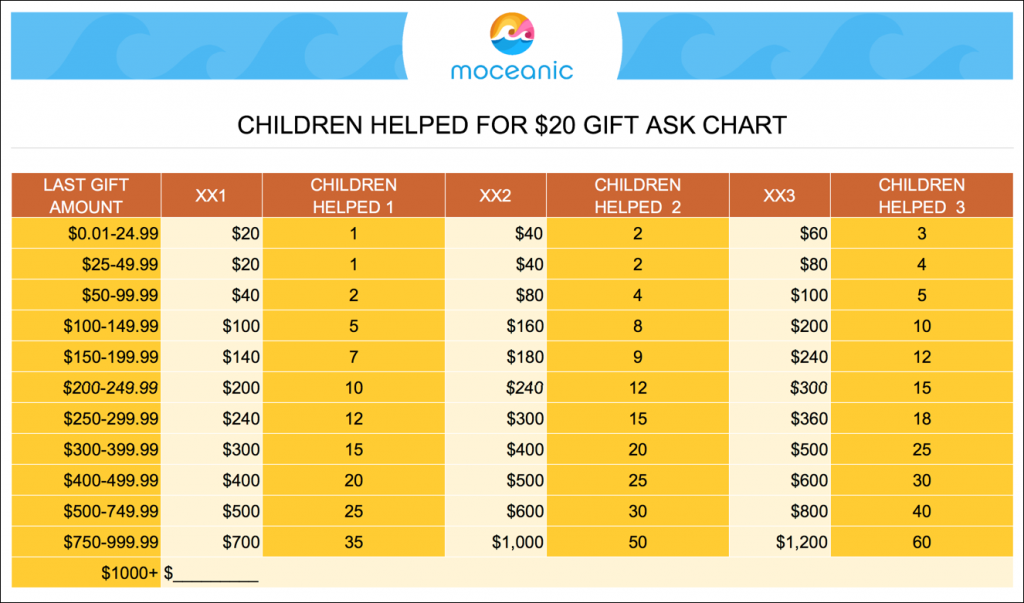Or: How to Avoid Looking Like You Don’t Know Your Donors
In this blog, I refer to the gift ask chart. You can get your own gift ask chart to download as an excel file. Just click here.
What’s worse than asking a $25 donor for $1,000?
Probably asking a $1,000 donor for $25.
Either one basically tells the donor — in flickering red neon 10-foot-tall letters:
WE DON’T KNOW YOU!
And really, it’s almost as bad if you’re off less dramatically, like asking a $50 donor for $250. The message is still We don’t know you.
So how do you ask the right amount of each donor?
When I first started in fundraising, I worked at a shop where we’d create three versions of every appeal:
- A Donors: Those whose last gift was more than $500.
- B Donors: Those whose last gift was between $100 and $500.
- C Donors: Those whose last gift was under $100.
In theory, the three versions had related but different offers. A Donors might be asked to feed everyone in the project for a month, B Donors for a week, and C Donors for a meal at a time.
You could then write to the giving scale of each donor group. It was cumbersome. And the bands were, I thought at the time, awkwardly wide. And writing three almost-but-not-quite-the-same letters was surprisingly taxing.
There’s a better way — in fact, a couple of better ways — to ask every donor the right amount.
Here’s one. The Gift Ask Chart:

This simple Excel spreadsheet is based on an offer in which $20 will “help” one child. (Please excuse the vagueness of this offer; it’s just an example! You can get your own gift ask chart here.)
The first column groups the donors by the amount of their last gift to the organization. Sometimes the amount is their largest gift, their largest give in the last 12 months, or some other way of segmenting them.
The first row with amounts is for faulty records in the data. After that, it’s simple amount ranges. It’s worth noting that typically in each range, the donors are clustered at the low amount.
For a donor whose last gift was at least $50, but under $100, this chart would yield an ask array like this:
$40 to help 2 children
$80 to help 4 children
$100 to help 5 children
You can also work it into the copy, so that same donor might find a paragraph like this in her letter:
Would you be willing to help 2 children today for a gift of $40? Or maybe you can help 4 children by donating $80. And if you really want to make a difference, your gift of $100 will help 5 children.
One advantage to the gift ask chart is you can see all the possible ask for donors at every level. You can give it the “smell test” — do the amounts feel right?
(Note that in the spreadsheet, there are no specific ask amounts for donors above $1,000. It’s pretty common to have open asks only for donors above a certain level, suggested amounts are as likely to downgrade what they will give as it is to guide them.)
This spreadsheet is available for download here. You can then modify it for your currency, your donor levels, offer, etc.
There’s another way to get almost the same thing: Use Calculations. This is how that looks:
$[donor’s last gift, rounded to nearest $20] to help [ask amount/20] children
$[donor’s last gift * 1.5, rounded to nearest $20] to help [ask amount/20] children
$[donor’s last gift * 2, rounded to nearest $20] to help [ask amount/20] children
The downside of this method is you can’t see the actual numbers it will produce. Use this method only if you have super-smart data people who can make sure it won’t produce nonsense, like three all-the-same ask amounts.
It’s great to ask donors appropriate amounts, and these are two ways to do that. But it isn’t magic! You still have to have a compelling offer — something they’re thrilled to do with their donations.
You can get your own gift ask chart to download as an excel file. Just click here.
Please share your experience with asking donors the right amounts by leaving a reply below. We’d love to learn from your experience. And you can post any questions you have about the gift ask chart here too.











2 Comments. Leave new
I have used a similar method to customize appeals. It is very effective.
As you note, Jeff, the TERRIBLE thing is to demonstrate to the prospect/donor that you do NOT KNOW THEM. It’s disrespectful and stupid. Ask for too little and I’m looking at the organization and thinking, “Why you’re dumb and haven’t paid attention to me.” Ask for tooooooo high and I’m thinking, “Wow. I’d love to have some of the drugs you’re taking!” Our picking might not be perfect… but let’s be as respectful and caring as possible.